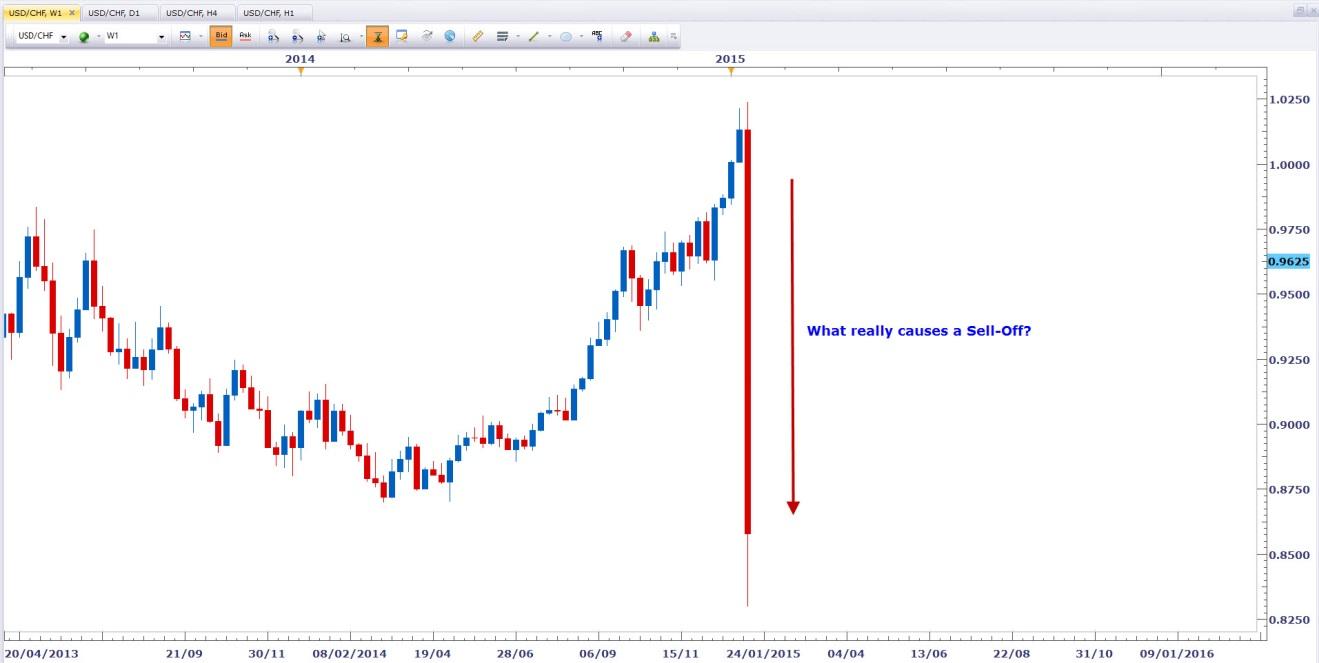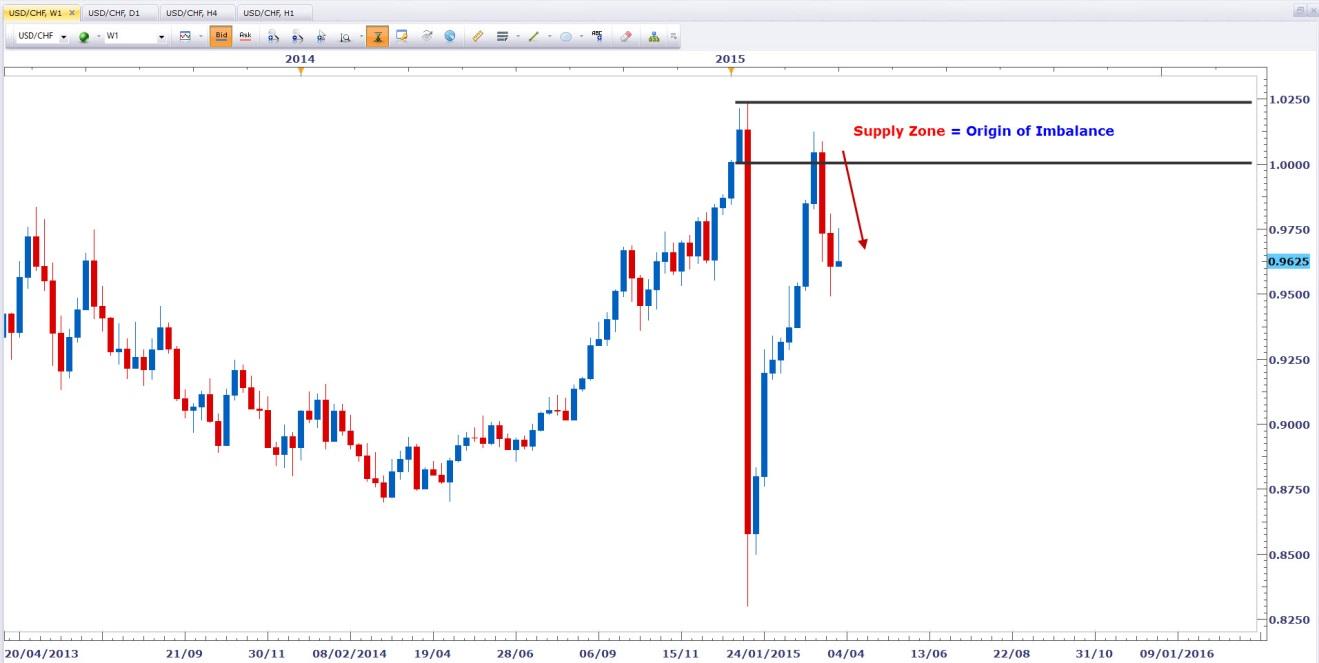![]()
Last week I had the pleasure of meeting up with an old trading friend who I have not seen in a while. Obviously, it didn’t take us very long to start talking about recent volatility in the global currency markets. Looking back over 2015 so far, the first quarter has seen plenty of action, but by far the biggest event we have seen was, without a doubt, on January 15th when the Swiss National Bank scrapped its three-year-old cap on the Franc sending the currency soaring against the Euro. Not only was the affect felt against the Euro but also against other major currencies as well, with plenty of price action happening alone in the USDCHF currency pair, with it being one of the most popular things to trade. We brought up the chart of the USDCHF and reflected on the price action of that day which led us into a discussion about market volatility and what really makes markets move.
This is a topic I obviously love discussing, what with being an instructor at Online Trading Academy it never gets old talking about the unique dynamics of what really is behind the moves we see on a day to day basis. Whenever I meet a new group of students in the classroom, one of the first things I like to introduce them to is our rules based core strategy and how an understanding of imbalances between supply and demand show themselves on a price chart and also provide us with low risk trading opportunities. A basic understanding of the supply and demand laws state this: if demand is greater than supply then prices must rise. If supply is greater than demand then prices must fall. The key, therefore, is to recognize where the imbalances that cause these moves can be found on the chart. If you learn to find the imbalances, then you will learn to find the trades.
This dynamic is so important yet so misunderstood. The majority of people today still believe that the reason prices go up is due to there being more buyers than sellers. Likewise, most people will also tell you that the reason markets go down is due to the fact that there are more sellers than buyers. How many times have you seen the market rallying and heard people talking about the Bulls being in control, or a market collapsing and saying that the bears are in control? It is believed that markets are going up because more people are buying and that those buyers are therefore in control. Likewise, it is also assumed that when the sellers are in control markets naturally fall. When you see a big parabolic green or red candle on a price chart this assumption is easy to make, however, there is more to this dynamic than meets the eye. When we truly understand what causes volatility and makes a market rally or fall, we begin to gain an edge in our trading and investing. Let’s take a look at a screenshot from the SNB unpegging aftermath and the price action on USDCHF as a result:
That fateful day, the USDCHF saw a drop of nearly 2000 pips in the shortest possible time. Now, when looking at a huge red candle like that it is easy to see why one could assume that more people were selling than actually buying because of the drop in price and the ferocity in which it happened. However, the reality behind that move is slightly different in that it was really caused by there being more willing sellers than were willing to buy. Do you see the difference? For their various reasons, many more people were willing to sell USD at the start of the drop than the amount of people who were willing to buy USD. If there had been as many willing buyers at the price level where there were willing sellers, the price would have simply stayed the same because there would have been equilibrium. The fact that there weren’t as many buyers willing to step in at the price that the majority of sellers were hoping to enter is what really caused the drop. In fact, the stark reality shows us that the majority of willing buyers were not prepared to enter the market until just before 0.8250. At this price there were now more willing buyers than there were willing sellers, thus prices started to rise.
The truly interesting thing we can take from this drop, however, is that once a low was created the chart suggested to us that the market had a really decent chance of rallying back to where it dropped from originally. You may be asking yourself why? Well, simply because the origin of the imbalance occurred at the origin of the drop itself, which in turn created the level of supply. The supply level was only created because not enough people who were willing to sell at that price got their orders filled. Once the buyers stepped in after that drop, the path of least resistance was objectively back to the origin of supply, as we can see here:
As we can see, the market did rally back to the origin of the initial drop, which was made easier due to the fact that there were no other levels of imbalance for it to deal with on the way back up. As the market is pushing back down again now, objectively it looks like there is an imbalance around 0.9250 which could be another decent buying opportunity.
So what can we take from this? Can we take advantage of such market volatility? I found that my own trading benefited greatly once I truly understood that down markets were actually being controlled by the people who were willing to buy, and that rallying markets were really being controlled by the people who are willing to sell. Prices will continue to move up or down until they find the next majority of orders and it is these unfilled orders from the past which become the most likely obstacle to halt the current direction of any market. I have found through my own education that sometimes we need to learn to think a little bit differently if we ever hope to achieve different results to what we have right now.
Note: All information on this page is subject to change. The use of this website constitutes acceptance of our user agreement. Please read our privacy policy and legal disclaimer. Opinions expressed at FXstreet.com are those of the individual authors and do not necessarily represent the opinion of FXstreet.com or its management. Risk Disclosure: Trading foreign exchange on margin carries a high level of risk, and may not be suitable for all investors. The high degree of leverage can work against you as well as for you. Before deciding to invest in foreign exchange you should carefully consider your investment objectives, level of experience, and risk appetite. The possibility exists that you could sustain a loss of some or all of your initial investment and therefore you should not invest money that you cannot afford to lose. You should be aware of all the risks associated with foreign exchange trading, and seek advice from an independent financial advisor if you have any doubts.
Editors’ Picks
EUR/USD holds firm above 1.0700 ahead of German inflation data

EUR/USD trades on a firm footing above 1.0700 early Monday. The pair stays underpinned by a softer US Dollar, courtesy of the USD/JPY sell-off and a risk-friendly market environment. Germany's inflation data is next in focus.
USD/JPY recovers after testing 155.00 on likely Japanese intervention

USD/JPY is recovering ground after crashing to 155.00 on what seemed like a Japanese FX intervention. The Yen tumbled in early trades amid news that Japan's PM lost 3 key seats in the by-election. Holiday-thinned trading exaggerates the USD/JPY price action.
Gold price bulls move to the sidelines as focus shifts to the crucial FOMC policy meeting

Gold price (XAU/USD) struggles to capitalize on its modest gains registered over the past two trading days and edges lower on the first day of a new week, albeit the downside remains cushioned.
Ripple CTO shares take on ETHgate controversy, XRP holders await SEC opposition brief filing

Ripple loses all gains from the past seven days, trading at $0.50 early on Monday. XRP holders have their eyes peeled for the Securities and Exchange Commission filing of opposition brief to Ripple’s motion to strike expert testimony.
Week ahead: FOMC and jobs data in sight

May kicks off with the Federal Open Market Committee meeting and will be one to watch, scheduled to make the airwaves on Wednesday. It’s pretty much a sealed deal for a no-change decision at this week’s meeting.
RECOMMENDED LESSONS
Making money in forex is easy if you know how the bankers trade!
Discover how to make money in forex is easy if you know how the bankers trade!
5 Forex News Events You Need To Know
In the fast moving world of currency markets, it is extremely important for new traders to know the list of important forex news...
Top 10 Chart Patterns Every Trader Should Know
Chart patterns are one of the most effective trading tools for a trader. They are pure price-action, and form on the basis of underlying buying and...
7 Ways to Avoid Forex Scams
The forex industry is recently seeing more and more scams. Here are 7 ways to avoid losing your money in such scams: Forex scams are becoming frequent. Michael Greenberg reports on luxurious expenses, including a submarine bought from the money taken from forex traders. Here’s another report of a forex fraud. So, how can we avoid falling in such forex scams?
What Are the 10 Fatal Mistakes Traders Make
Trading is exciting. Trading is hard. Trading is extremely hard. Some say that it takes more than 10,000 hours to master. Others believe that trading is the way to quick riches. They might be both wrong. What is important to know that no matter how experienced you are, mistakes will be part of the trading process.


